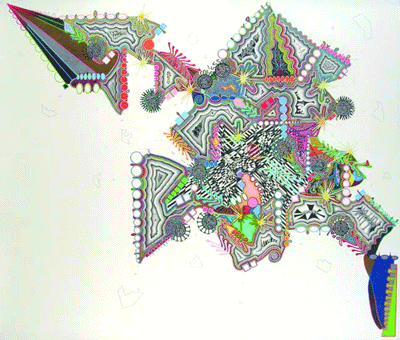John J. O’Connor’s strange and unfamiliar metric forms
The door to the gallery could have a sign, “Mad Scientist at Work/Large Unexplainable Drawing Ahead.” Like Petri dishes in a lab, these drawings resonate with strange and unfamiliar forms. The exhibition’s title, “One Hundred Days In a Year,” seems to imply the solar system has gone metric. This may be close to the truth as the work of John O’Connor compares and contrasts with measurement precision with drastic results.
Improbable connections are O’Connor’s specialty, using a wide range of references from topical culture to history to mysticism. The large drawing titled “Dr. Atkins’ Code of Independence” (2005) began as an inquiry into the ancient Egyptian grid system representing social hierarchy. Text from varied sources was used to encode the grid. The result is a brilliantly hand colored drawing that looks computer generated. The pixilated forms strike a precarious balance, with echoing upper and lower sections. The texts used––“The Farmers’ Almanac,” Dante’s “Inferno,” “The Da Vinci Code,” among others—are written along the outer parameter of the drawing. The labor-intensive whole is like organized confetti, an image resulting from a unique merger of thought, futility, and effort.
Executed in colored pencil and graphite, these quirky, linear drawings can look like exploded schematics, or elaborate filing systems converted into strange two-dimensional origami. The incorporation of words, faint or bold, brings the viewer back to the source ideas. “Husky” (2005) has the look of a Mandela that has morphed out of its symmetry. The artist’s daily weight fluctuations, carefully calculated are the point of departure.
All the works, colorful, dense, and extremely involved, are rescued from overwhelming chaos by the judicious use of emptiness that surrounds them. Some drawings are on subtle colored backgrounds but most are on white paper. Many of the compositions are centrally placed and somewhat predictable.
“Local” (2005) examines the state by state relationship of obesity, binge drinking, and overall safety and could resemble an African king’s robe with an unusual organism filling its center. One of the largest drawings in the exhibition, “Prediction Error”(2005), is bold in its use of composition as the drawing seems to unfold across the space.
Through his use of the scientific and sociological as a ruse, O’Connor acts as systems analyst conveying and compiling information into visual systems that challenge. These daring works that reference Fluxus, Dada, and Chaos Theory ultimately question rationality itself.
gaycitynews.com


































